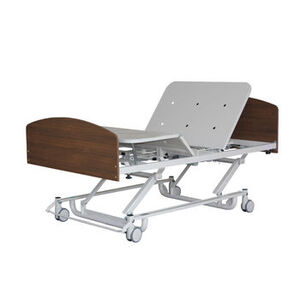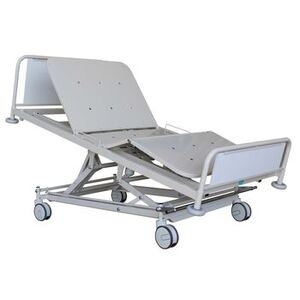At Access Rehabilitation Equipment, we commit to providing you and your loved ones solutions for life! Fitting your lifestyle, each aid and equipment is tailored to the unique challenges you are facing, so work with us to find the independence and mobility you want!

As obesity rates continue to surge in populations, the demand for bariatric services is rapidly increasing, and medical facilities need the proper equipment to care for them safely. Overweight and obese individuals require treatment not only for weight management but also for various health issues linked to obesity. Patients also need appropriate equipment to ensure their safety and comfort in their homes. When selecting equipment to meet their unique needs, the patient's safety, comfort, and dignity should be the utmost priorities.
Bariatric beds are one example of essential equipment for bariatric patients that suit their specific width and weight requirements. The larger design provides greater comfort to the patient and helps healthcare professionals with more efficient means of moving and treating them. These modifications help to minimise the risk of injury or infection and support productive recovery and a healthier way of life.
Choosing the right bariatric bed can be a complex process due to the multitude of features to consider. Read on to find out everything you should know before making your decision.
What size is classified as bariatric?

The classification of a bariatric size can vary depending on the context, but generally, it refers to individuals who are significantly overweight or obese. When referring to bariatric beds, these beds are typically designed to support individuals with a weight capacity of 350 pounds (about 159 kilograms) or more.
To be classified as bariatric, the World Health Organization defines eligibility as having a BMI(Body Mass Index) of 40 or weighing at least 100 pounds over your ideal body weight. Individuals with a BMI of 30 or higher could also fall into the bariatric category and might find a bariatric bed more suitable for their needs.
Why might a bariatric person require a (bariatric) hospital bed?
A bariatric hospital bed offers several benefits compared to standard medical beds, including increased safety, comfort, and convenience. These bed frames are purpose-built to withstand more weight than traditional beds, providing better support for bariatric individuals. This, in turn, aids to prevent bedsores which can result from excessive pressure on the skin from extended time in bed, health complications, and friction injuries.
Bariatric hospital beds also provide more room than regular beds, allowing for a more comfortable body positioning. Additionally, bariatric hospital beds often incorporate built-in features, such as handrails or adjustable bed settings, that can aid in improving mobility.
What is the difference between a bariatric bed and a hospital bed?
One significant difference between traditional hospital beds and bariatric beds is their size and weight capacity. Bariatric beds are designed to accommodate larger and heavier patients, providing broader dimensions and a higher weight capacity than traditional hospital beds, which cater to patients with lower weight requirements, usually ranging from 280-490 pounds (or 127-222 kilograms) and have narrower dimensions.
Another distinguishing factor is the added safety and support provided by bariatric beds. They often come equipped with reinforced frames, robust support structures, and integrated safety features such as side rails to ensure patient safety and comfort. In contrast, standard hospital beds are generally lighter in construction and may lack the enhanced safety features required for bariatric patients.
Bariatric beds may also offer specialised features, such as adjustable head and foot sections, tailored to the specific medical needs of larger patients, which are designed to enhance patient comfort and facilitate medical care.
Key Features of Bariatric Beds Include:
- Wider sleeping surface
- High weight capacity
- Reinforced & robust frame
These differences make bariatric beds an essential equipment for hospitals and healthcare facilities, ensuring the secure and comfortable care to bariatric patients.
What is the measurement of a bariatric bed?
The measurement of a bariatric bed can vary depending on the specific model, but typically, these beds often have a width of around 90 and 150 cm (about 36 and 60 inches) and a length of approximately 225 cm (around 88 inches).
What is the weight requirement for a bariatric bed?
Bariatric beds safely support individuals with a weight capacity starting at 150 kilograms (about 350 pounds) or more. Some bariatric beds can support even higher weight capacities, ranging from 275 kilograms (approximately 600 pounds) to 450 kilograms (about 1,000 pounds) or more, depending on the bed’s construction and intended use.
What is the best bariatric bed?
The best bariatric bed for an individual depends on their specific needs and preferences. Some factors to consider when choosing a bariatric bed include weight capacity, mattress type, adjustability, budget and additional features like safety rails or electronic controls.

We recommend the Alrick Bariatric Bed 2300 King Single Series that can handle a maximum user weight of 350 kg. Providing the ultimate experience, this bariatric bed ensures safety for both patients and caregivers through features like auto regression backrest, back-lit handset and under-bed light. Additionally, the electric hi/low function and 125mm braking castors make it easy to adjust the bed according to your needs, while the curved head and foot panels add a touch of luxury.

For much larger patients, the OW2400 Series Bariatric Bed provides the ultimate comfort with its safe working load of 400 kg. Equipped with 150mm twin wheel locking castors, this spacious bed can be effortlessly and safely positioned. The multiple positions available with this bariatric bed are beneficial in relieving muscle cramps and discomfort, promoting better blood circulation, and reducing the risk of pressure sore development.
Conclusion
By having your questions answered, you’re better equipped to make informed decisions, ensuring the utmost comfort and care for bariatric patients. Remember, the right bariatric bed not only promotes well-being but also aids healthcare professionals and caregivers in delivering effective treatments. We advise reaching out to your healthcare provider or a medical equipment specialist for guidance to ensure that the bed you choose is tailored to your specific requirements.


 Providing solutions for life
Providing solutions for life







